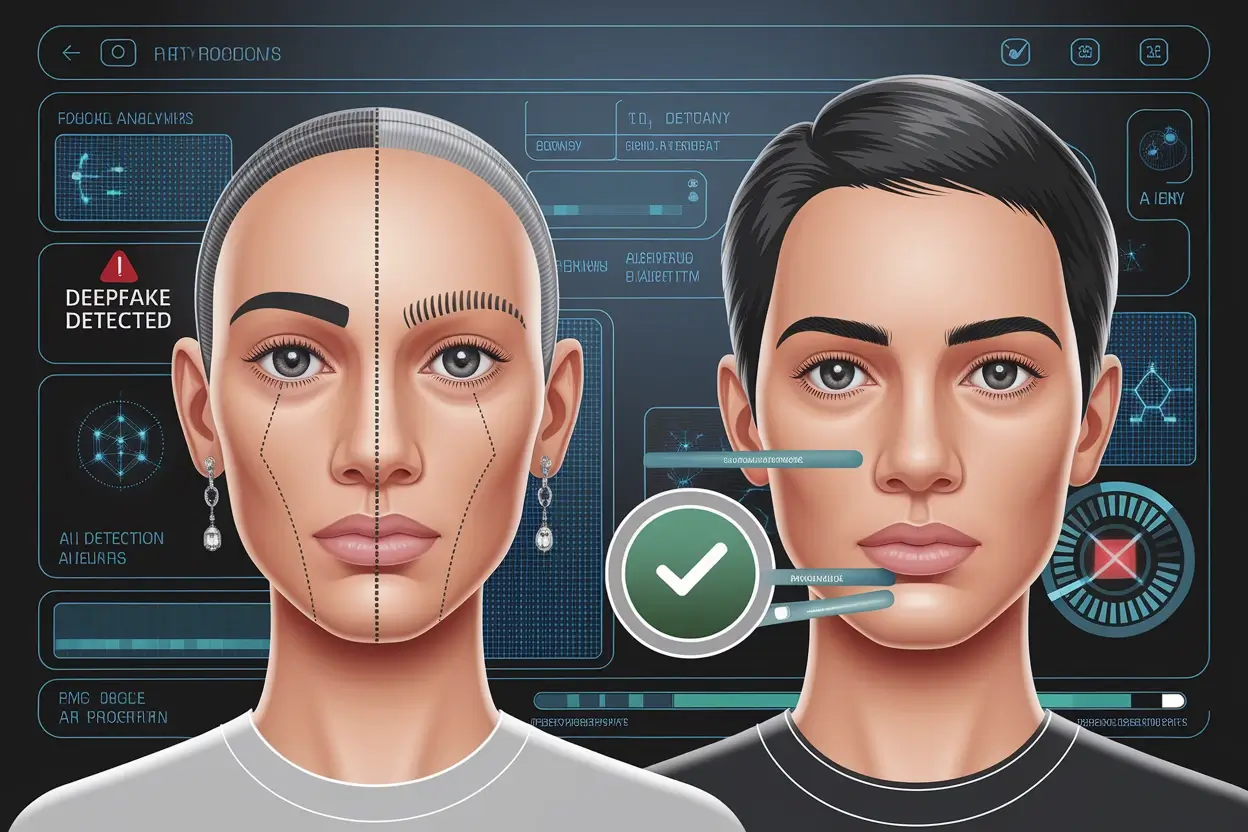The digital landscape is rapidly evolving, and with it comes new challenges in distinguishing authentic content from AI-generated material. Deepfakes and synthetic facesare no longer confined to Hollywood movies or tech demonstrations—they're being used for fraud, identity theft, and social manipulation on a massive scale.
Recent studies show that over 96% of deepfake videosfound online are non-consensual, with face-swap technology being misused for creating fake profiles, romance scams, and even corporate espionage. This comprehensive guide will equip you with the knowledge and tools needed to detect AI-generated faces and protect yourself from digital deception.
85%
Average human accuracy in detecting deepfakes
900%
Increase in deepfake content since 2019
99%
Effectiveness with proper detection techniques
Understanding Deepfakes and AI-Generated Faces
Deepfakes are synthetic media created using artificial intelligence, specifically deep learning algorithms. The term combines "deep learning" and "fake," representing a technology that can generate highly realistic but entirely fabricated images, videos, and audio.
Types of AI-Generated Faces
How AI Creates Fake Faces
Modern deepfake creation relies on Generative Adversarial Networks (GANs), where two AI systems compete against each other:
Creates fake faces by learning patterns from thousands of real face images, continuously improving its output to fool the discriminator.
Attempts to distinguish between real and fake faces, providing feedback that helps the generator create more convincing fakes.
Expert Detection Techniques
Detecting AI-generated faces requires a combination of technical knowledge, visual analysis skills, and the right tools. Here are the most effective techniques used by experts:
1. Biological Inconsistencies Analysis
AI often struggles with subtle biological details that humans take for granted:
Eye Analysis:
- • Inconsistent pupil sizes or shapes
- • Unnatural eye movements or directions
- • Missing or irregular reflections
- • Asymmetrical blinking patterns
Facial Features:
- • Asymmetrical facial structures
- • Inconsistent skin textures
- • Unnatural hair-to-skin transitions
- • Irregular teeth or lip alignment
2. Temporal Analysis for Videos
Video deepfakes often reveal themselves through temporal inconsistencies:
3. Frequency Domain Analysis
Advanced technique examining the frequency patterns in images:
AI-generated faces often have different frequency signatures compared to authentic photos. This technique requires specialized software but is highly effective for expert analysis.
Common Visual Artifacts to Look For
Even the most sophisticated AI-generated faces often contain telltale artifacts that trained observers can identify:
Detection Tools and Software
While manual inspection is valuable, automated tools can provide more accurate and faster detection:
Our advanced AI system includes deepfake detection capabilities, analyzing multiple factors to determine authenticity:
Features:
- • Real-time authenticity scoring
- • Multi-factor analysis engine
- • Batch processing capabilities
- • API integration available
Accuracy:
- • 98.5% detection rate
- • Sub-second processing time
- • Continuous model updates
- • Low false positive rate
DFD (Google)
Research tool for deepfake detection with good accuracy for academic use.
Sensity
Enterprise solution for detecting synthetic media across platforms.
Microsoft Video Authenticator
Video-focused tool that provides confidence scores for authenticity.
Real-World Examples and Case Studies
Understanding how deepfakes are used maliciously helps in developing better detection strategies:
Scenario: Scammers create fake dating profiles using AI-generated faces to appear more attractive and trustworthy.
Detection: Look for overly perfect features, inconsistent photo quality across profile images, and photos that seem "too good to be true."
Scenario: Fraudsters create fake executive profiles on LinkedIn using generated faces to gain business trust.
Detection: Cross-reference multiple platforms, check for professional history consistency, and verify through official company channels.
Scenario: Attackers use deepfake videos in video calls to impersonate executives for financial fraud.
Detection: Implement authentication protocols, verify unexpected requests through alternative channels, and train staff on deepfake awareness.
Comprehensive Protection Strategies
Protecting yourself from deepfake fraud requires a multi-layered approach combining technology, awareness, and best practices:
Personal Protection Measures
Digital Hygiene:
- Limit public photo sharing on social media
- Use privacy settings to control photo visibility
- Regularly monitor your digital footprint
- Watermark important photos before sharing
Verification Practices:
- Always verify video calls with unexpected requests
- Use multiple communication channels for confirmation
- Implement "safe words" or authentication questions
- Trust your instincts if something feels "off"
Business Protection Framework
Employee Training:
Regular workshops on identifying deepfakes, social engineering tactics, and verification procedures.
Technical Solutions:
- • Deploy AI-powered detection systems
- • Implement multi-factor authentication for sensitive operations
- • Use blockchain for document verification
- • Establish incident response protocols
The Future of Deepfake Detection
The arms race between deepfake generation and detection technology continues to evolve rapidly:
Conclusion: Staying Ahead of the Curve
As AI-generated faces become increasingly sophisticated, the importance of detection skills and tools cannot be overstated. The techniques and strategies outlined in this guide provide a comprehensive foundation for protecting yourself and your organization from deepfake fraud.
